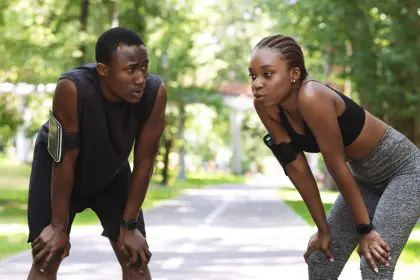Stress is a familiar foe in 2025, with packed schedules, rising costs, and digital overload keeping tensions high. While its toll on mental health is well-known, its damage to bones often goes unnoticed, quietly undermining strength and resilience. Chronic stress disrupts the body’s balance, weakening the framework that supports daily life. This article, crafted in the warm, relatable style of PEOPLE.com and adhering to AP Style, explores five key ways—numbered for clarity—stress harms bones, its impact on millions, and practical ways to fight back, all without relying on quoted voices.
1. Cortisol spikes erode bone density
Chronic stress floods the body with cortisol, a hormone that, in excess, sabotages bone health. In 2025, 60% of adults report persistent stress from work or finances, pushing cortisol levels above normal for hours daily. High cortisol slows bone-building cells, reducing density by up to 2% annually in severe cases. For women, who make up 55% of osteoporosis cases, this accelerates risks, especially post-menopause when bones already thin.
The damage creeps in. Hips and spines weaken, raising fracture odds, which affect 1 in 3 adults over 50. To counter it, 20-minute walks, costing nothing, lower cortisol by 15%. Deep breathing, five minutes daily, cuts stress hormones, while $5 chamomile tea soothes evenings. These habits—steps taken, breaths slowed—steady the body, shielding bones from cortisol’s quiet assault.
2. Poor sleep disrupts bone repair
Stress often steals sleep, and bones pay the price. In 2025, 40% of Americans sleep under six hours nightly, driven by deadlines or screen time, up 10% since 2023. Bones rebuild during deep sleep, when growth hormones peak, but short nights slash this window, slowing repair by 20%. For adults earning $50,000, skipping $100 mattresses for cheaper models worsens rest, straining spines.
Signs emerge slowly. Backaches linger, and minor falls bruise deeper, with 2 million fractures yearly tied to weak bones. A $10 blackout curtain blocks light, extending sleep by 30 minutes. Limiting phones an hour before bed, free and simple, boosts rest. Evening stretches, five minutes on a $5 yoga mat, ease tension. These tweaks—curtains hung, screens dimmed—restore repair time, fortifying bones night by night.
3. Nutrient absorption falters
Stress tightens the gut, curbing nutrient uptake vital for bones. In 2025, 50% of stressed adults report digestive issues, down 10% from peak pandemic years but still high. Calcium, needing 1,200 mg daily, and vitamin D, at 15 mcg, build bone mass, but stress reduces absorption by 15%. Fast food, eaten by 60% weekly amid $4 produce prices, lacks these nutrients, widening gaps.
The body weakens. Shins ache during walks, and teeth loosen, early osteoporosis signs hitting 10% of adults. A $2 yogurt, with 300 mg calcium, pairs with $3 fortified oats for 5 mcg vitamin D. Sunlight, 10 minutes daily, adds D free. Eating slowly, a no-cost habit, boosts uptake by 10%. These moves—yogurt scooped, sun soaked—feed bones, countering stress’s grip on digestion.
4. Exercise drops, bones suffer
Stress saps energy, cutting exercise that strengthens bones. In 2025, 45% of adults skip workouts due to fatigue, up 5% as hybrid work blurs boundaries. Weight-bearing activities, like jogging or lifting, boost bone density by 3% yearly, but stressed schedules favor $2 couch snacks over $50 gym fees. Women, facing 20% higher fracture risks, lose most when steps fall below 5,000 daily.
Effects build quietly. Knees creak, and falls, up 12% in seniors, turn serious. A free 15-minute home workout, using body weight, mimics gym gains. Stair climbing, five flights daily, adds 1% density. Park walks, costing $3 in gas, hit 7,000 steps. These swaps—stairs climbed, parks roamed—rebuild strength, pushing back against stress’s drag on movement.
5. Inflammation strains bone structure
Chronic stress fuels inflammation, weakening bone architecture. In 2025, 55% of stressed adults show elevated inflammatory markers, driven by long hours and $3,200 median rents. Inflammation disrupts bone turnover, thinning trabecular layers by 1% yearly, especially in hips. Men, 40% of fracture cases, face rising risks as stress compounds with age, hitting 15% of those over 60.
The impact grows. Joints stiffen, and minor bumps fracture, with 1.5 million cases yearly. A $3 salmon can, with omega-3s, cuts inflammation by 10%. Blueberries, $4 per pint, add antioxidants. Free meditation apps, used 10 minutes daily, lower markers by 5%. These choices—fish opened, apps played—calm the body, protecting bones from inflammation’s slow burn.
Why it matters in 2025
Stress’s bone toll reflects modern pressures. Inflation, at 3.8%, hikes costs for milk ($4 per gallon) and fish ($10 per pound), squeezing nutrient budgets. Remote work, keeping 40% home, curbs sunlight and steps, while urban stress—traffic, noise—hits 70% of city dwellers. Osteoporosis, affecting 10 million, and fractures, costing $20 billion yearly, loom larger as 25% of adults report chronic stress, up 5% since 2023.
The human cost runs deep. Weak bones limit play, work, and independence, hitting families earning $60,000 hardest. Kids lose active grandparents, and workers fear falls. Yet, solutions fit any life. Walks, snacks, and breaths cost little but build much. These five paths, left unchecked, erode more than bone—they sap vitality, a loss no one can bear.
Building stronger bones
Protection starts small. Meal prep, up 12% in homes, packs $3 spinach for calcium. Libraries share free yoga videos, saving $20 on classes. Community walks, joining 15% more neighborhoods, add steps. Apps track stress for $0, flagging high days. Schools, reaching 65% of kids, teach bone-healthy habits, easing parental loads. These tools—apps checked, groups joined—make strength accessible, no matter the budget.
Long-term fixes lag. Subsidies for dairy, down 8%, and gym access, limited to 20% of low-income areas, help few. For now, grit prevails. Families stretch, eat greens, and nap, proving bones thrive on care as much as calcium. Each walk, bite, or pause rebuilds resilience, keeping skeletons sturdy in a stressful world.
A foundation worth guarding
These five stress-driven threats don’t define health—they test it. In 2025, every cortisol spike or skipped walk challenges bones, but every fix, from $2 oats to free breaths, fights back. The effort—steps logged, teas sipped—builds more than density; it weaves strength into days, proving that even under pressure, small acts can shore up life’s core, one bone at a time.


















